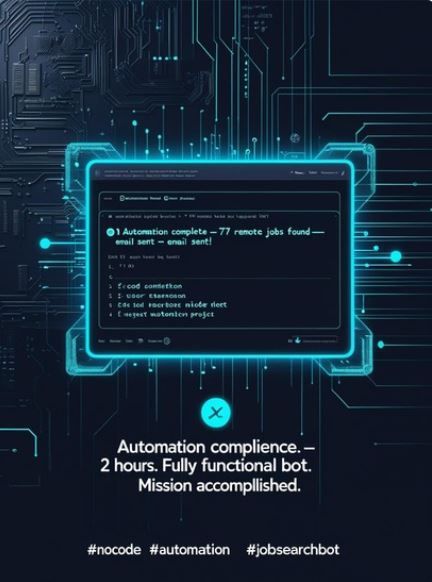The 8‑Hour Bet
It started as a dare to myself: eight hours on the clock, zero “real” coding experience, and one ambitious goal—ship a working, fully automated job‑search bot. Sixty‑five minutes later, I was staring at my inbox… with a clean, formatted report of roles tailored to my skills and salary targets. The bot worked on the first run.
Constraint as a Superpower
I didn’t know Python beyond copy‑paste and curiosity. But the modern stack rewards a different muscle: delegation. Instead of brute‑forcing syntax, I broke the problem into small, testable steps and used AI prompting like a power tool. When I got stuck, I asked better questions—about logic, structure, and edge cases—then glued the answers together.
The Toolkit That Made It Click
I opened Visual Studio Code and built a minimal workspace. With AI as my copilot, I stitched together:
- Python for the scriptable glue and reliable libraries
- Open APIs & RSS feeds from job boards for public listings
- Local filtering to match skills and salary ranges
- Email automation to package results into a weekly digest

First pass, first win—clean, relevant listings delivered to my inbox.
Guardrails First: Automation With Respect
This wasn’t “scrape and pray.” I only touched public data and respected platform terms. No rate‑limit hammering, no TOS gray areas. If automation is going to earn trust, it has to behave like a good citizen.
The Build: From Noise to Signal
The first successful run felt like catching a wave. The bot:
- Fetched roles from multiple trusted sources
- Filtered locally by skills and salary targets
- Deduplicated the overlap across sources
- Emailed a clean, scannable report
Set It and Forget It
I wanted reliability, not another tool I had to babysit. So I wired it into Windows Task Scheduler to run weekly. Now, every seven days, I get a curated list of roles that actually fit.

Hands‑off consistency: a weekly run that keeps opportunity flowing.
The Payoff
By the end of day one, I wasn’t “learning to code”—I was shipping value. My inbox started delivering 70+ relevant remote roles weekly, ready to review and prioritize. No doom‑scrolling, no wasted clicks—just leverage.
What I Learned (That Isn’t Just “Coding”)
- Delegate to AI for speed, but keep the logic yours
- Use public data respectfully—trust beats hacks
- Filter locally to turn firehoses into streams
- Schedule it so the system works even when you don’t
The Future of Work, Today
This project wasn’t about flexing tools. It was about owning a problem and solving it with a modern toolkit. That’s the future of work: proactive, ethical automation that removes drudgery and amplifies focus.
Frequently Asked Questions
It uses AI prompting and public job board APIs to find, filter, and email relevant job listings based on your skills and salary targets.
No coding is required. The bot is built with simple scripts and automation tools anyone can use.
Yes, it only uses public data and respects platform terms of service. No scraping or rate-limit abuse.
The bot is scheduled to run weekly, delivering a curated list of new opportunities to your inbox.

About the Author
Kyle Mohney is a technologist, writer, and AI enthusiast. He explores the intersection of memory, creativity, and collaboration in the age of artificial intelligence.
